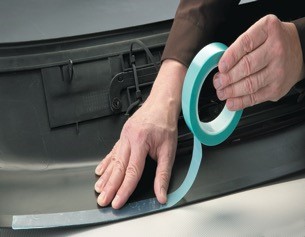
Adhesive tape and sealants are found in a variety of auto manufacturing processes including:
- Front- and rear-end modules (for precise masking of bumpers)
- Door panels and seating systems
- Attaching parts to fuel tanks
- Sealing and mounting windshields
- Numerous powertrain applications (like bonding magnets to rotors in electric cars)
According to Adhesives.org, crash tests have demonstrated that glued cars perform much better than welded designs. Impact-resistant adhesives are made from a variety of chemicals like the polyolefins that are used in everything from shoes to athletic equipment. Also attributable to the improved performance is the fact that adhesives allow for the use of lightweight aluminum instead of steel. During a collision, adhesives act as a buffer, so most of the impact energy gets transformed into deformation energy, which means improved passenger safety. Vehicle manufacturers adopting aluminum and automotive adhesive safety advantages include Ford, Audi, Mercedes-Benz, and Land Rover. In fact, when the Ford F-150 upgraded from steel to an aluminum-alloy body, the National Highway Traffic Safety Administration (NHTSA) raised its crash safety test rating from four to five stars.
Innovations in high impact adhesives are dramatically improving car safety, with a reduction in car-body intrusion space during an accident. The new adhesives are also delivering superior impact peel values, which refers to a method used to measure the resistance to cleavage fracture of structural adhesives. Even places that were never considered for adhesive use, such as upper/lower rail attachments and inner/outer rocker panel joints, are benefiting from this new generation of automotive adhesives.
Another difference from traditional welds, is the adhesive’s ability to protect a vehicle throughout its service life. That is important not only for vehicle manufacturers, but also for collision-repair professionals. If an impact-resistant adhesive tape is damaged or must be removed, it should be replaced by the same type of product. Substituting a different kind of adhesive tape or sealant can end up compromising driver safety.
